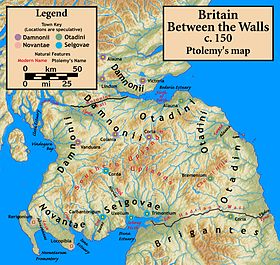
The Votadini, also known as the Uotadini, Wotādīni, Votādīni, or Otadini[1] were a Brittonic people of the Iron Age in Great Britain. Their territory was in what is now south-east Scotland and north-east England, extending from the Firth of Forth and around modern Stirling to the River Tyne, including at its peak what are now the Falkirk, Lothian and Borders regions and Northumberland. This area was briefly part of the Roman province of Britannia. The earliest known capital of the Votadini appears to have been the Traprain Law hill fort in East Lothian, until that was abandoned in the early 5th century. They afterwards moved to Din Eidyn (Edinburgh).
The name is recorded as Votadini in classical sources, and as Otodini on old maps of ancient Roman Britain.[2] Their descendants were the early medieval kingdom known in Old Welsh as Guotodin, and in later Welsh as Gododdin [ɡoˈdoðin].
One of the oldest known pieces of British literature is a poem called Y Gododdin, written in Old Welsh, having previously been passed down via the oral traditions of the Brythonic speaking Britons. This poem celebrates the bravery of the soldiers from what was later referred to by the Britons as Yr Hen Ogledd – The Old North; a reference to the fact that this land was lost in battle to an invading force at Catraeth (modern day Catterick).
- ^ Claudius Ptolemaeus, Geographia (c. 2nd century)
- ^ [1] Map of Ancient Britain]